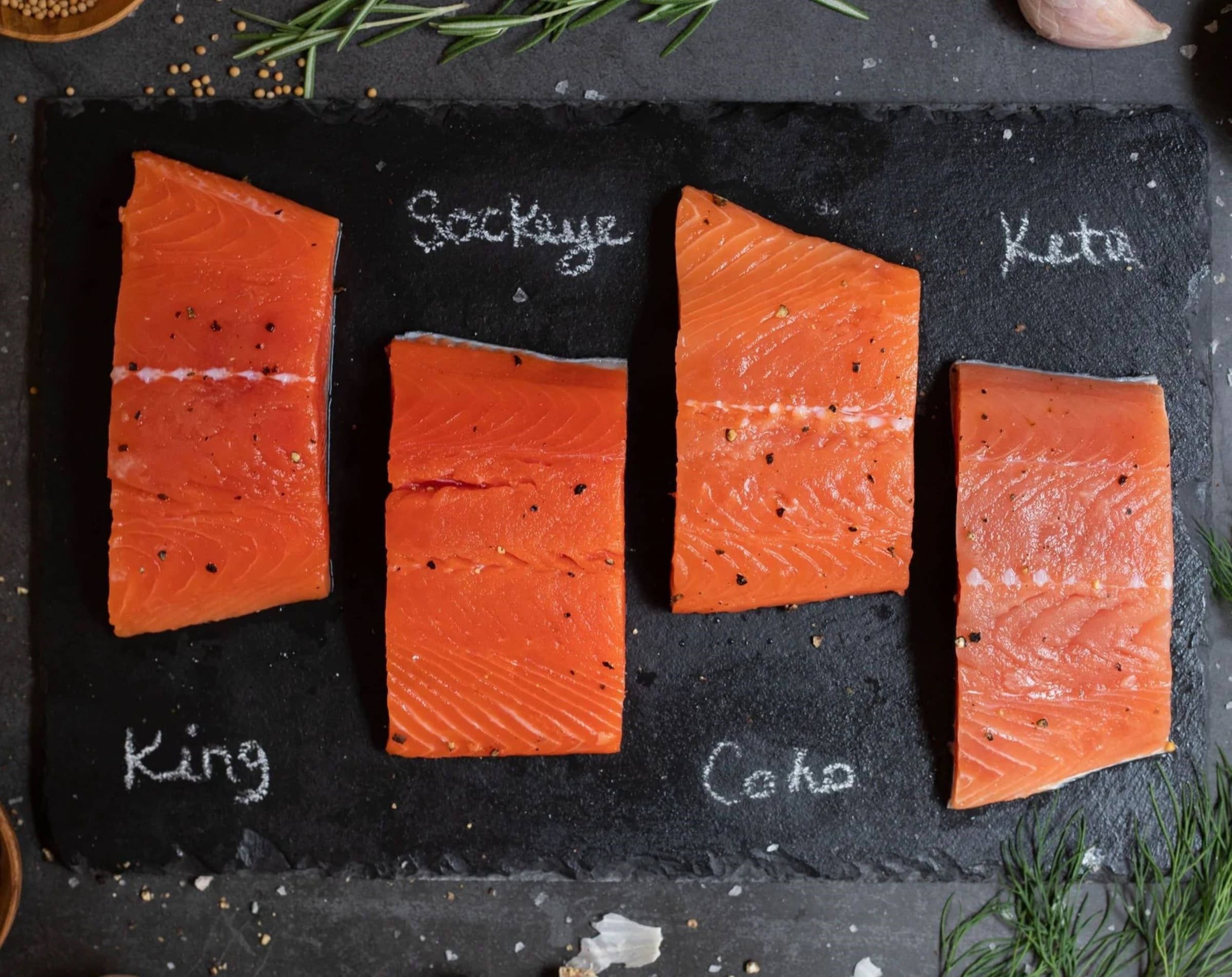Before joining Sitka Seafood Market as Culinary Director, my salmon knowledge was woefully lacking. Most of the recipes I’d developed and tested for various magazines and books (including chef’s recipes) just mentioned salmon in the ingredient list — no qualifier, no differentiator. Sure, I knew of the various species, but I only really cooked with king and so took it to be the benchmark by which all salmon was measured. Coho was fine, sockeye OK, and keta barely registered. Forget about pink salmon — that I only knew in those tall red cans that my mom kept in the pantry (which certainly has its merits).
In fact, every species has its merits. More important (well... my opinion), each is unique and uniquely delicious and just requires a bit of knowledge to tease out the best qualities.
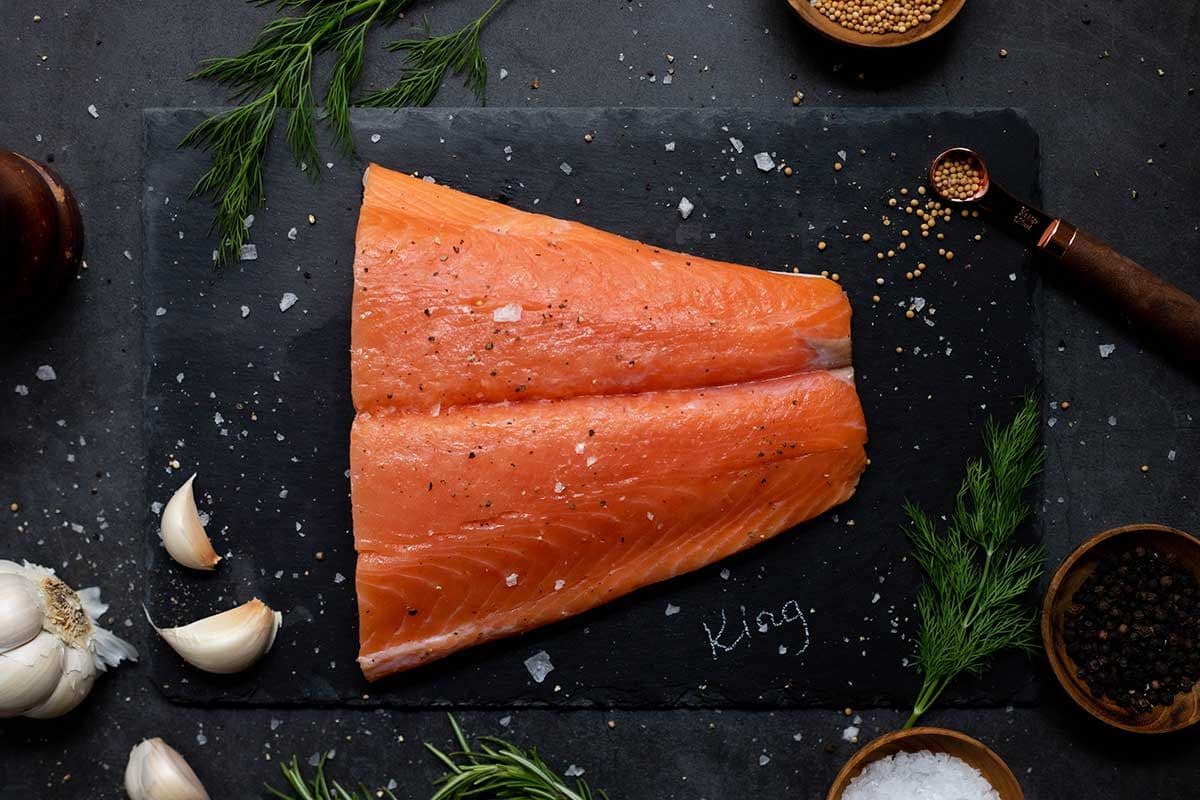
King/Chinook
Rich, fatty, silky texture, with large, luscious flakes — these qualities alone crown this species king, but it’s the size that gave them that name. On average, at almost 35 pounds and 45 inches long, this is the largest species of salmon. Some king are bright orange and others are pale or even white. Those salmon can’t metabolize orange-colored carotene (found in the shellfish they consume).
Firm yet delicate texture with high fat content makes king versatile in the kitchen.
Do
- Sear in a blazing-hot pan until both sides are golden and crisp yet a bit rare in the center (125°F). This is a quick and foolproof cooking method. Just don’t try to flip the fish until it releases easily from the pan. Learn more about how to get perfect crispy skin.
- Use the equally foolproof “low-and-slow” method. As implied, salmon is roasted at a low temperature for a relatively long time. It’s especially good for salmon cooked all the way through because the even heat allows the meat to stay incredibly moist.
- For medium rare (125°F): 20 minutes at 300° (1½ inches thick)
- For cooked through (145°): 25 to 35 minutes at 300°F
- Try it raw. King is stellar in raw or near-raw preparations because of its silky, melt-in-your-mouth texture.
- Make gravlax (overnight salt/sugar cure), ceviche (quick acid cure), crudo, carpaccio, tartare, or sashimi (totally raw, lightly dressed). Read about the 3 C’s of Raw Fish.
- Be assertive with seasonings and dressings. King’s bold and buttery meat make it a good candidate for more assertive seasonings and acidic dressings to balance the richness. Spice rubs like harissa and tandoori or tart salsas like chimichurri and charmoula work well with rich king.
Don’t
- Don’t grill over low or indirect heat unless the salmon is on a cedar plank or other platform that allows the salmon to cook on one side. Trying to flip salmon over a low flame is a tricky and stick-y proposition.
- Don’t skip pin bone removal. Nothing derails a premium eating experience like a bone in the throat! Check out our step-by-step pin bone removal guide or simply watch the 30-second video below.
- Don’t “waste” king in tacos, stir fries, or chopped into burgers. Of course it’ll be ah-maz-ing, but let it take center stage and center plate!
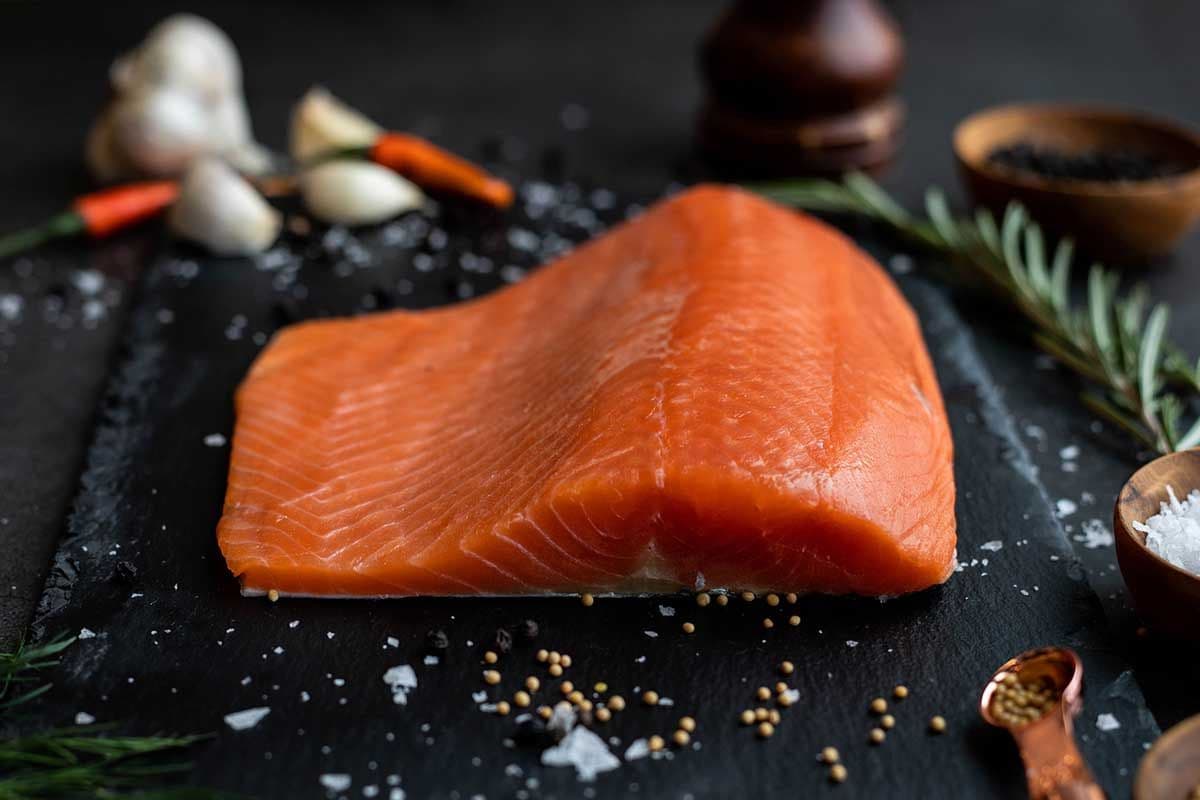
Coho/Silver
Slightly firmer and leaner than king, coho is no less delicious and versatile. With large meaty flakes and slightly mild flavor, coho is great roasted, grilled, raw, and in chowder. All of the do’s and don’ts for king salmon apply to coho, however, because it is leaner, you’ll need to pay special attention to cooking times and temperatures to avoid drying out.
Do
- Invest in an instant read thermometer. Look for one with the sensor at the tip — it gives a more accurate reading. Thermapen is my favorite. Go for 125°F for medium rare, 135°F for medium and 145°F for cooked through.
- Grill over direct heat. Coho’s slightly firmer texture makes it great for direct-heat grilling. Always clean the grates and rub with oil (oil the fish, too). Make sure the grill is preheated before adding the fish, otherwise it will stick mercilessly and can become overcooked before getting that nice char. The same goes for a grill pan. Check out my simple recipe for Grilled Salmon with Tabbouleh and Fresh Green Harissa.
- Lean into coho’s delicate flavor with subtle, mild applications or go whole-hog with assertive seasonings. Either way, always, always season well with salt and pepper — before and after cooking.
Don’t
- Don’t throw out that skin! Most recipes don’t require skinning salmon unless you’re adding salmon to chowders or curries or making tartare or ceviche — all great choices for coho. Don’t throw out that skin! It’s packed with nutrients and makes amazing fish bacon! Rub it with oil, sprinkle with seasonings (I like a mixture of smoked salt, brown sugar, and coarse black pepper), and bake between 2 baking sheets (425°F) until crispy.
- Don’t forget to trim the gray flesh (aka, bloodline) underneath the skin for raw preparations. It has a stronger flavor but is packed with omega-3 fatty acids. Its removal is purely an aesthetic choice, in other words, not necessary but suggested.
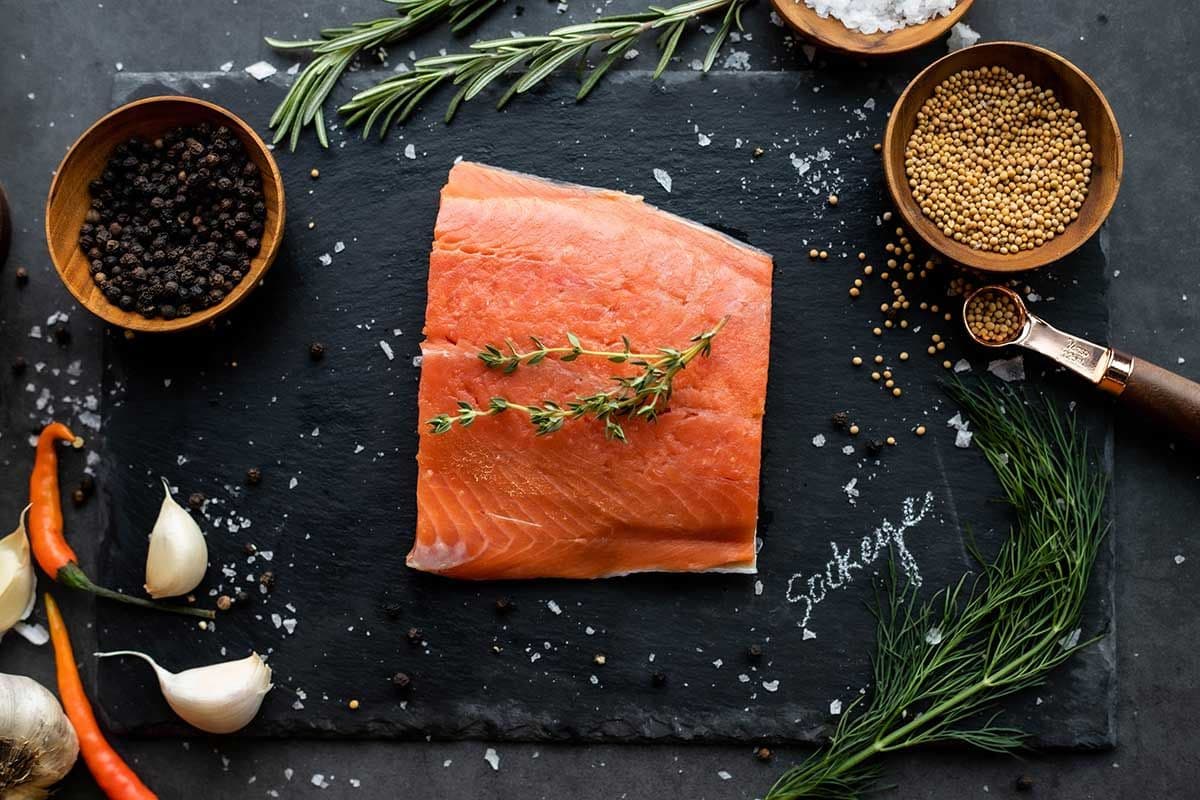
Sockeye/Red
The first thing you notice about sockeye is its striking red-orange flesh. Smaller than other species, sockeye average 4 to 8 pounds, which often means we get full-sized fillets. This makes for an especially dramatic table presentation, not to mention easy to slice gravlax. Delightfully fatty, deeply flavored, and beautifully colored, sockeye truly delivers on that wild Alaska salmon promise.
Do
- Meet sockeye’s intensity head-on with strong spice rubs or flavorful sauces. Creamy sharp horseradish sauce is yummy as is a bright and tart lemon-caper-shallot vinaigrette.
- Serve raw or cured. The dense, firm flesh makes sockeye a great fish for serving raw or cured. Slicing gravlax made with sockeye couldn’t be easier. Grab hold of the tail end for stability and slice from the thicker end. Watch here for my clever trick to keep the knife from sticking!
- Add large hunks of skinless sockeye to soups, stews, and chowders for an instant flavor infusion.
Don’t
- Don’t overcook! All that luscious fat won’t keep sockeye from drying out if it’s overcooked, which is easy to do because of the relative thinness of the fillets. Sockeye is great for super-quick high-heat pan-searing or grilling, just be sure to pull it from the heat when it registers 125°F on an instant read thermometer.
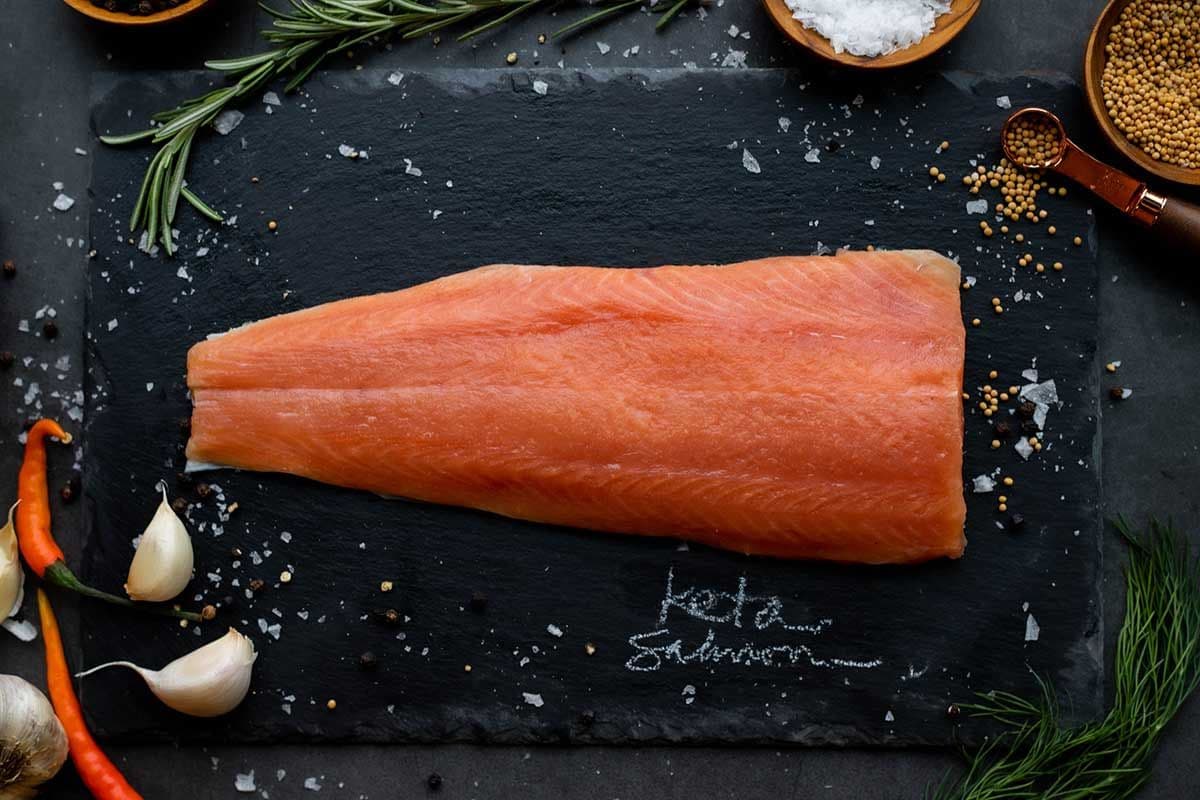
Keta (Also Called Chum or Dog Salmon)
This species is known by several misleading names — none of which sound particularly appealing, but taste is a completely different kettle of fish. Keta is meaty, lean, and delicately flavored and is the perfect blank slate for all sorts of applications. Think pink white fish. Anything cod can do, keta can do better. Yes it can, yes it can!
Do
- Make salmon burgers. Keta’s mild flavor and firm texture make it a great choice for salmon burgers. After skinning and trimming, simply hand-chop the salmon, mix it with a little binder (panko and mayo), lots of herbs or spices, and pan fry it for juicy, flavorful burgers. Check out the recipes for my Tex-Mex, Ginger-Scallion, and Parsley-Dill Salmon Burgers.
- Add some fat. The leanest of the salmon species, keta does really well with some added fat. Salmon rillettes is basically a combination of fat (butter, cream cheese or creme fraiche), cooked salmon, and aromatics that are folded together to make the ultimate spread. A little rendered bacon fat adds not only richness but smokiness.
- Use moist heat to cook. Fold big hunks of skinless salmon into creamy chowders or coconut-based curries that impart richness and flavor. This 20-minute Thai Green Fish Curry makes the perfect weeknight meal.
- Fry it up! Looking for a new fish to fry? Keta may be the hidden gem you’ve been searching for. Breaded and fried, it’s crispy on the outside and moist and tender on the inside. Serve it in these baja style tacos or directly on brown-paper with killer homemade tartar sauce.
- Try it raw or lightly cured. Keta is even a good choice for gravlax and ceviche, especially if assertively seasoned and served with a creamy dressing or ripe avocados.
Don’t
- Don’t overcook. Keta’s leanness makes it really easy to overcook. Chowders, soups, and curries hide a multitude of sins — still it’s best to add it near the end and not cook too long.
- Don’t single-skewer! Keta kebabs, well-seasoned and well-oiled, work well on the grill but can be hard to turn without spinning on the skewer. Easy fix? Line up the ingredients for a kebab (fish, veggie, bread, repeat) in a row and thread onto 2 parallel skewers. Try this recipe for halibut kebabs which is equally delicious with keta. Don’t forget to brush with oil!
Ready to cook? check out our delicious seafood recipes for some culinary inspiration!
Not yet a member? Receive monthly deliveries of wild-caught salmon and receive delicious recipes along with your deliveries. As an added benefit, you'll also receive expert cooking advice from our amazing culinary team.

